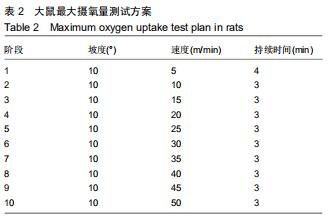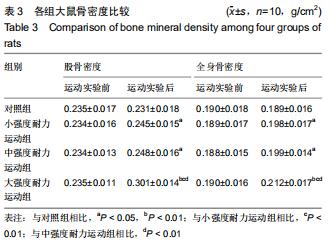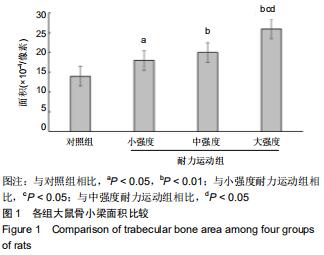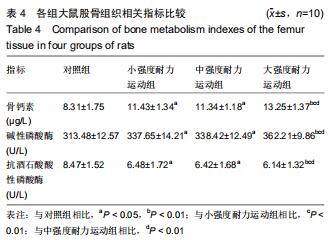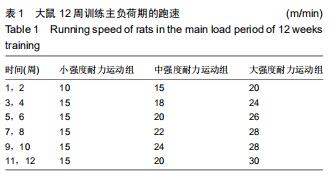中国组织工程研究 ›› 2020, Vol. 24 ›› Issue (35): 5582-5588.doi: 10.3969/j.issn.2095-4344.2918
• 骨组织构建 bone tissue construction • 上一篇 下一篇
不同强度耐力运动干预下生长期大鼠骨细胞代谢水平的变化
陈泽刚1,丁海丽2,李 龙1,王 纯2
成都体育学院,1研究生院, 2运动与健康学院,四川省成都市 610041
Changes of bone metabolism after different intensity endurance exercises in growing rats
Chen Zegang1, Ding Haili2, Li Long1, Wang Chun2
1Graduate School, 2School of Sport and Health, Chengdu Sport University, Chengdu 610041, Sichuan Province, China
摘要:

文题释义:
运动干预工程:指运用运动学、生理学、组织学、行为学和保健学等多学科方法,对人或者动物的行为、意识、细胞、组织等的研究而提出的假设,然后经过多重性质的广泛证明和实践检验成为理论的系统性工程。
骨代谢:指骨的细胞持续进行的细胞代谢,既有骨的细胞之间的相互作用,也有骨髓中红细胞生成细胞、基质细胞的相互作用,它是骨改建和重建最为重要的方式。
背景:随着社会的发展和人们生活水平的提升,处于生长发育敏感期的青少年健康日益受到关注。运动可改善骨细胞代谢,但有关耐力运动对生长期大鼠骨细胞代谢水平影响方面的研究不多。
目的:探讨不同强度耐力运动对生长期大鼠骨细胞代谢水平的影响。
方法:实验方案经成都体育学院运动与健康学院动物伦理委员会批准。选择40只大鼠适应性训练1周后,随机分为对照组、低强度耐力运动组、中强度耐力运动组、高强度耐力运动组。对照组大鼠常规饲养,不进行训练干预。各运动实验组训练12周,每周训练5 d,每天训练60 min。每2周进行一次最大摄氧量测试,根据测试结果调整后2周的训练负荷。小、中、大强度耐力运动组主负荷期的运动强度为分别为50%,65%及80%最大摄氧量。运动训练实验后观察各组大鼠骨密度、骨结构、骨代谢的指标变化。
结果与结论:①关于大鼠股骨骨密度、全身骨密度,运动实验后,小、中等强度耐力运动组与对照组相比均有改善(P < 0.05);大强度耐力运动组优于小强度耐力运动组、对照组(P < 0.01)。小、中强度耐力运动组运动实验前、后相比差异有显著性意义(P < 0.05);大强度耐力运动组运动实验前、后相比差异有非常显著性意义(P < 0.01)。②关于大鼠骨小梁面积,运动实验后,小强度耐力运动组、中强度耐力运动组与对照组相比均有改善(P < 0.05);大强度耐力运动组显著优于对照组(P < 0.01);大强度耐力运动组优于小、中强度耐力运动组(P < 0.05)。③关于大鼠股骨组织中骨钙素、碱性磷酸酶、抗酒石酸酸性磷酸酶等指标,运动实验后,小、中强度耐力运动组与对照组相比均有改善(P < 0.05);大强度耐力运动组显著优于对照组 (P < 0.01);大强度耐力运动组优于小、中强度耐力运动组(P < 0.05)。④关于大鼠血清中骨钙素、碱性磷酸酶、抗酒石酸酸性磷酸酶等指标,运动实验后,小强度耐力运动组、中强度耐力运动组与对照组相比均有改善(P < 0.05);大强度耐力运动组显著优于对照组(P < 0.01);大强度耐力运动组优于小、中强度耐力运动组(P < 0.05)。⑤结果说明,不同耐力运动干预可不同程度地改善生长期大鼠骨密度、骨结构、骨组织、血清等指标,促进生长期大鼠骨生长,其中大强度耐力运动效果最佳。
ORCID: 0000-0003-1455-871X(陈泽刚)
中国组织工程研究杂志出版内容重点:组织构建;骨细胞;软骨细胞;细胞培养;成纤维细胞;血管内皮细胞;骨质疏松;组织工程中图分类号:

